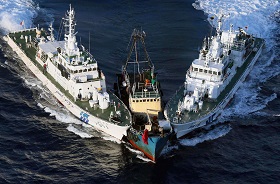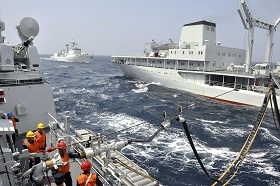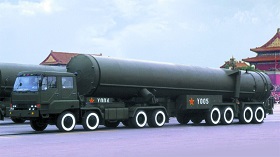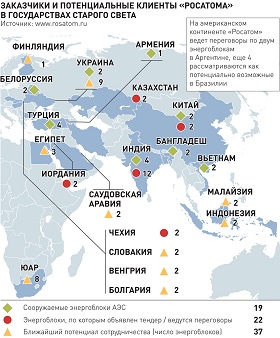Russia’s Nuclear Strategy in Northeast Asia
(no votes) |
(0 votes) |
Northeast Asia is one of the most important regions in modern global nuclear policy. It is home to three legal nuclear powers (the United States, Russia and China), one illegal nuclear power (North Korea), and countries with a closed nuclear fuel cycle and developed civil nuclear power (Japan and South Korea). This makes Northeast Asia a region of crucial significance for Russia's nuclear strategy.
Northeast Asia is one of the most important regions in modern global nuclear policy. It is home to three legal nuclear powers (the United States, Russia and China), one illegal nuclear power (North Korea), and countries with a closed nuclear fuel cycle and developed civil nuclear power (Japan and South Korea). This makes Northeast Asia a region of crucial significance for Russia's nuclear strategy.
Regional Trends
In the next decade, Russia’s nuclear policy in the Asia-Pacific region will be shaped by the following factors.
Firstly, the United States is rebuilding its military presence in the Pacific Ocean. In mid-2010, the Obama administration announced its shift to an updated ‘containment of China’ strategy [1]. As part of that strategy, Washington has revived the activities of the ANZUS military-political bloc, started building a naval base in Singapore and initiated negotiations with Vietnam on strategic partnership. The ‘containment of China’ strategy still lacks clearly defined nuclear dimensions, but the United States is conducting consultations with South Korea to potentially redeploy tactical nuclear weapons (TNW) to the Korean Peninsula [2]. The United States also blocked an attempt by the Yukio Hatoyama administration (2009–2010) to expand Japan’s nuclear autonomy [3].
A special option afforded by this strategy is the creation of an International Monitoring System (IMS) of nuclear tests, which was set out for construction in the 1996 Comprehensive Nuclear Test-Ban Treaty (CTBT). Although the United States did not ratify the CTBT, seismic, hydroacoustic and infrared monitoring stations are being built on the territory of its allies. The largest of these hubs are located in Australia and New Zealand, as well as in Japan [4]. Beijing fears that Washington will use the IMS to monitor China’s strategic nuclear forces and nuclear test sites.
Secondly, China is cautiously modernizing its nuclear forces [5]. Back in 1995, China tested the Dong Feng 31 solid propellant intercontinental ballistic missile (ICBM), with an 8,000-kilometre range and believed to be equipped with systems that can overcome missile defence. Deployment began in 2007. According to the U.S. Department of Defence, the Dong Feng 31 was deployed in its mobile form on the MAZ-547V, which is identical to the Soviet RSD-10 Pioneer [6]. In the autumn of 2012, it was reported that China had finished working on its Dong Feng 31A ICBM, with range of up to 11,000 km [7]. It is assumed that Beijing could start producing Kh-65SE or Kh-15 air-launched cruise missiles with a range of up to 600 km (their guidance accuracy will be increased if China deploys its Beidou Navigation Satellite System). However, the large-scale modernization of Chinese nuclear potential so feared by American experts in the 1990s [8] has yet to occur [9]. This is apparently because China lacks any significant contributions to theoretical physics and because Beijing is oriented towards importing weapons instead of creating a military industrial complex.
China’s nuclear policy emphasizes the naval component of strategic nuclear forces. In 2010, Fudan University (Shanghai) Professor Shen Dingli proposed the ‘string of pearls’ concept [10], whereby a series of naval bases is established along the hydrocarbon transit route from the Middle East to China. This idea theoretically involves the construction of a Chinese ocean fleet and heightened attention on the naval component of strategic nuclear forces. In the spring of 2007, experts at the U.S. Department of Defence believed that China would start deploying Ju Lang-2 submarine-launched ballistic missiles (SLBM) in 2010–2012. It was believed that China would have five to eight new-generation nuclear submarines by 2012 [11]. However, China’s ability to create such potential is disputable.
Thirdly, there is a sustained threat of conflict on the Korean Peninsula. North Korea sees its nuclear programme as a means of obtaining economic preferences and is not seeking war with the United States or South Korea. However, Pyongyang does want its threats to Washington, Tokyo and Seoul to be taken seriously, and it is constantly heightening the pitch of these threats [12]. The ‘third nuclear alarm’ that was set off in the summer of 2009 still lingers. New tensions arose in the spring of 2013, when North Korea conducted more nuclear tests and withdrew from the 1953 ceasefire agreement [13].
Tensions on the Korean Peninsula have influenced Japan’s military policy by giving Tokyo grounds to expand its military autonomy. Tokyo acquired missile defence systems from the United States that are in Japan’s national jurisdiction. During the crises surrounding launches of North Korean carrier rockets in March 2009 [14] and December 2012 [15], the Ministry of ForeignAffairs of Japan announced that it was ready to use missile defence systems in case of a real threat to Japanese territory. If such a threat materialized, it would serve as a pretext for Tokyo to use force outside of the Japanese archipelago.
Fourth, there is an ever-present danger of nuclear proliferation in the region [16]. Japan is the most likely candidate for the role of a new nuclear power. In 1971, the Eisaku Sato administration adopted its Three Non-Nuclear Principles: non-production, non-possession and non-introduction. However, prior to that, in 1957, the Japanese politicians announced that Tokyo was entitled to produce nuclear weapons if U.S. security guarantees weakened. In 1994, former Japanese Prime Minister Tsutomu Hata said that Tokyo had the potential to create nuclear weapons but that it would not do so in light of international constraints. In 2002, Chief Cabinet Secretary Yasuo Fukuda, his deputy (current Prime Minister) Shinzo Abe and opposition leader Ichiro Ozawa came forth with similar announcements. On November 8, 2006, in response to North Korean nuclear tests, Japanese parliamentarians urged the government to consider whether the production of nuclear weapons would violate the Japanese constitution. The discussion was suppressed under U.S. influence in January 2007.
Uncertainty also remains with respect to South Korea’s nuclear option. At the beginning of the 1980s, South Korean physicists conducted experiments to separate plutonium from spent nuclear fuel without reporting those tests to the International Atomic Energy Agency (IAEA). On November 11, 2004, the IAEA adopted a resolution condemning another experiment South Korea performed in 2000 to split 0.2 grams of uranium [17]. Seoul’s potential acquisition of a nuclear weapon resurfaced in the spring of 2013 when, on April 11, deputy of the South Korean parliament Chung Mong-joon declared that South Korea had the right to withdraw from the Non-Proliferation Treaty (NPT) to protect itself from the North Korean nuclear threat [18]. In response, on April 11, 2013, the United States’ Chairman of the Joint Chiefs of Staff General Martin Dempsey voiced Washington’s opposition to redeploying TNWs to the Korean Peninsula and its refusal to support the nuclear ambitions of its allies [19].
Fifth, the future of Japanese nuclear power is still ambiguous. By the end of 2010, the country had 50 active reactors producing 30 per cent of all domestically consumed electricity [20]. A promising area of Japan’s nuclear power industry is the development of fast-neutron reactors (fast-breeder reactors), which are able to quickly regenerate spent nuclear fuel. In the aftermath of the Fukushima disaster on September 14, 2012, the Yoshihiko Noda administration adopted a nuclear phase-out programme scheduled for completion by 2040 [21] that would increase the number of coal-fired power plants and ramp up exports of liquefied natural gas (LNG). However, the Second Shinzo Abe Cabinet revised that decision. At the beginning of 2013, Japan launched the Ohi-3 and Ohi-4 reactors and the Monju fast-breeder reactor. On December 20, 2013, Prime Minister Shinzo Abe declared that the nuclear phase-out plan had been irresponsible and that it was more important to tighten safety standards at nuclear power plants [22]. Ten reactors are scheduled for re-launch in the summer of 2014 [23].
Six, ‘Fukushima syndrome’ has had no influence on the development of nuclear power in other East Asian countries. China is still rolling out its nuclear programme. As of February 2014, Beijing had 17 active nuclear reactors and 6 nuclear power plants, 32 blocks under construction, and 54 in the design stages [24]. The State Council of the People’s Republic of China imposed a moratorium on building new power units after the Fukushima disaster, but it lifted that moratorium on October 24, 2012 [25]. The National Development and Reform Commission of the Government of the People’s Republic of China plans to increase the share of nuclear power in the country’s energy balance from 2 per cent in 2013 to 6 per cent in 2020 [26].
South Korea has not reconsidered its priorities, either. The country had 21 nuclear power units with PWR and CANDU reactors in 2012. Combined, its nuclear power plants have an 18.5-GW capacity from 21 reactors. That is 29.5 per cent of all power-generating capacities in South Korea, but 45 per cent of the country’s total power consumption [27]. On November 11, 2009, the South Korean leadership voiced its intentions to build another 11 power units [28]. On January 29, 2014, the government approved a plan to construct two new nuclear power plants worth $7 billion by 2020 [29]. In May 2012, South Korea started constructing two new reactors, the components of which will be entirely domestically produced [30].
Northeast Asia has been teetering on the brink of a major war for the last 30 years, and yet it has still managed to avoid conflict. There are two circumstances at play. The first is a system of ‘hegemonic stability’ based on the American military presence. The second is the absence of developed militaristic traditions in the region (with the exception of Japan) and adherence to peaceful conflict resolution. However, ‘nuclearization’ has been on the rise in the Asia-Pacific region in the 2010s, which objectively makes the region more vulnerable to a potential military conflict.
Russian Military and Political Priorities
U.S. containment remains a priority in the Russia’s nuclear strategy. Three factors will increase the significance of this policy:
- An aggravation of territorial disputes between the United States and Russia due to the shelf zones division in the Barents Sea;
- The United States’ continued policy of supporting Japan in its territorial disputes with Russia;
- The redeployment of American nuclear weapons to the Korean Peninsula.
That said, the threat of a U.S.–Russia military conflict in the Asia-Pacific region remains low. Both sides are aware that such a conflict could quickly escalate into a nuclear war. The only potentially dangerous scenario would be if Russian–Japanese territorial disputes were to intensify and the United States were to intervene in that conflict. However, Russia and Japan resumed their dialogue in August 2013, thereby reducing a threat of direct clashes between Moscow and Tokyo.
The U.S. strategy objectively restricts the resources Russia needs to drive an export policy in nuclear power. Beijing may perceive possible Russian contacts with U.S. allies as a violation of the Russian–Chinese ‘Big Treaty’ of 2001. Southeast Asia is beginning to view Russia as China’s strategic partner.

Tokyo Electric Power Co (TEPCO) workers work
Fukushima Daiichi nuclear plant. June 12, 2013
During Mikhail Gorbachev’s visit to Beijing in June 1989, the Soviet and Chinese heads of state struck a preliminary agreement on the principles of demarcation of the Soviet–Chinese border and on the withdrawal of TNWs from the border area. Russian President BorisYelstin confirmed that agreement during a trip to Beijing in December 1992 [31]. Moscow and Beijing pledged not to aim nuclear weapons at each another in the Russian–Chinese ‘Big Treaty’ of 2001 [32]. This treaty outlines mutual commitment to refrain from using force in bilateral relations and to abide by a mechanism of compulsory consultations for the purpose of forging a common foreign policy position.
Meanwhile, Russia is indirectly involved in modernizing China’s strategic nuclear forces by providing the latter with rocket and space technology. This type of exchange is envisaged in a Russian–Chinese intergovernmental protocol dated March 25, 1996, as well as a partnership agreement on deep space research dated March 28, 2007. The success of China’s space programme from 2003 to 2007 was largely due to its preferential access to Russian rocket and space resources.
Russian–Japanese relations remain ambivalent. In Moscow, there are concerns that Tokyo could develop an illusion of security thanks to the American ‘nuclear umbrella’. In theory, this might encourage Japan to undertake limited and provocative military action, such as the scenario with the proclamation of sovereignty over the ‘Northern Territories’ (the scenario discussed by Russian experts during the crisis in bilateral relations in the winter of 2011). However, Japan’s lack of full-grade armed forces and nuclear weapons makes a Russian–Japanese territorial dispute unlikely. The risk of conflict subsided after Moscow and Tokyo initiated 2+2 consultations (involving the Ministries of Defence and Foreign Affairs of both countries) on November 1–2, 2013.
Russian leadership is concerned over the potential for conflict on the Korean Peninsula. Moscow assesses the likelihood of conflict in a variety of ways, ranging from high (during the ‘nuclear alarms’ of 1994, 2003 and 2010) to low (during the six-party talks). Russia is unlikely to be directly involved in the conflict. The Treaty of Friendship, Cooperation and Mutual Assistance signed by Russia and North Korea on February 9, 2000 does not contain mutual military commitments like the ones in the Soviet–North Korean alliance treaty of 1953. However, such a conflict would create serious environmental problems for the Russian Far East [33].
Moscow reacted negatively to North Korea proclaiming itself a nuclear power and subsequently testing its nuclear weapons. However, the Russian leadership was cautious about the signing of the Agreed Framework in 1994. The Kremlin saw this as a major American commercial project aimed at replacing North Korea’s old Soviet heavy water reactors with American light water reactors. Moscow adhered to its dual strategy at the six-party talks, expressing the desire for an‘informal coalition’ with China and South Korea, with a view to preventing a U.S. military operation against North Korea [34]. Russia’s only proposal to resolve the Korean conflict was a ‘package agreement’ it developed in January 2003. According to the Russian version of this agreement, Pyongyang would initiate nuclear self-disarmament under IAEA supervision in exchange for multilateral security guarantees and economic preferences [35].
Russian Energy Priorities
Russia’s commercial policy in Northeast Asia is still uncertain. Neither the USSR nor Russia had a palpable presence on the East Asia energy market. First of all, many countries in the region (Japan, South Korea) have already developed their own nuclear power. Secondly, the majority of countries in the region are oriented towards the United States in particular, and western business in general, with regards to nuclear energy. Thirdly, Russian products earned poor reputation after the Chernobyl disaster of 1986, as a result of which Soviet products were supplanted by ‘more reliable’ French and Dutch products.
North Korea was the USSR’s major regional partner in the nuclear power industry. Back in 1955, the two countries signed an agreement to cooperate in the peaceful use of nuclear energy. Soviet specialists helped build key nuclear infrastructure facilities in North Korea, including the Radiochemistry Research Institute and Yongbyon Nuclear Scientific Research Centre. In 1985, the USSR and North Korea came to an agreement that the former would supply the latter with a 25-megaton thermal reactor on graphite moderators and that North Korea would join the NPT.
However, Russia curtailed nuclear cooperation with North Korea in 1993. The October 21, 1994 signing of the ‘Agreed Framework’ showed that Pyongyang did not regard Moscow as a key nuclear partner. Russia did not join the Korean Peninsula Energy Development Organization established in 1995. Since then, Russian–North Korean nuclear contacts have ground to a halt.
The Chinese market, closed to the USSR since 1964, gave Russia the opportunity to compensate for its loss on the North Korean market. On December 29, 1997, China and Russia signed a contract to construct the Lianyungang Nuclear Power Station (later renamed the Tianwan Nuclear Power Station) on the coast of the Yellow Sea. Launched in the summer of 2007, the Tianwan Nuclear Power Station utilizes advanced VVER-1000 reactors and K-1000-60/30 turbine generators [36]. Russian state corporation Rosatom and China National Nuclear Corporation signed a protocol on the second phase of the TianwanNuclear Power Station and the start of work to create a breeder reactor (BN-800) on October 13, 2009 [37]. They also signed an intergovernmental protocol of cooperation to construct the third and fourth power units on December 6, 2012.
There are also blueprints for peaceful nuclear power cooperation between Russia and South Korea. Since 1997, theRepublic of Korea–Russian Federation Joint Coordinating Committee on Atomic Energy Cooperation has been meeting primarily to discuss scientific and practical issues associated with the use of nuclear power for peaceful purposes, including nuclear power plant safety. Russia covers up to 30 per cent of the fuel supplies for South Korea's nuclear power plants [38].
Russia does not address nuclear cooperation in its relations with Japan because of Tokyo’s position on the ‘Northern Territories’. Tokyo has broached the topic of ownership over these territories in every contact with Russia since 1982 [39]. The U.S.–Japanese peaceful nuclear cooperation agreement of 1968 is the basis of Japan’s nuclear policy. This document strictly rations Tokyo’s policy on the creation of nuclear fuel and equipment use [40].
Russian Priority Objectives

Masataka Morita
Andrey Gubin, Artyom Lukin:
Warring in North East Asia: Possible Scenarios
Russia’s nuclear strategy in the Asia-Pacific region will, for objective reasons, continue to face constraint in the next ten years. The American nuclear presence and U.S. control over its allies’ nuclear programmes will persist in the region in the foreseeable future (although the ‘nuclear option’ should not be ruled out for South Korea or Japan if there is a sharp escalation in the conflict on the Korean Peninsula). China does not yet possess the technological resources needed to rapidly build up its strategic nuclear forces and enhance their counterforce capabilities. China’s nuclear forces are still vulnerable to the U.S. and Russian counterforce threat. Influenced by this trend, China will ramp up its cooperation with Moscow in order to increase access to Russian technological resources.
Potentially dangerous for Russia is the outbreak of armed conflict in three scenarios. First, an attempt by China to solve the Taiwan issue with the use of force, which would engage Beijing in a conflict with the United States (a scenario that cannot be ruled out, despite a redoubling in the dialogue between Taipei and Beijing at the end of 2013). Second, a conflict on the Korean Peninsula, beginning on the model of cross-border clashes between North and South Korea. Third, Japanese rearmament and an attempt by Japan to solve its territorial disputes with its neighbours, including Russia, by force. However,the experience of the last 20 years has proven that the region’s leading powers lack sufficient political grounds for a nuclear conflict. The situation could change if there is a sharp disruption in the ratio of military potentials, or if the United States scraps its active presence in the region.
With respect to nuclear power, the situation looks unpromising for Russia. The only serious success could be an enhanced partnership with China and partly with South Korea. Russia has no other potential partners for more substantial successes. Therefore, Russia will be guided by four principles in Northeast Asia in the foreseeable future: expanded partnership with China (including in nuclear energy), participation in negotiations on North Korea’s nuclear programme, prevention of Japanese nuclearization, and a cautious dialogue with South Korea.
1. http://www.whitehouse.gov/sites/default/files/rss_viewer/national_security_strategy.pdf
2. http://www.anti-atom.ru/ab/node/2064 (in Russian).
3. In March 2010, the Yukio Hatoyama administration revealed secret agreements reached in the 1960s to redeploy American TNWs to the Japanese archipelago (especially to the U.S. base in Okinawa) in a critical situation. A special 1960 agreement gave the United States the right to transport aeroplanes and ships containing nuclear weapons through Japan without prior consultations with the Japanese government. On March 17,2010, the Ministry of Foreign Affairs of Japan confirmed that American ships containing nuclear weapons could stop at Japanese ports under ‘special circumstances’. Experts considered these statements to be the creation of a case for Tokyo to expand its military policy. For a detailed analysis, see our article: Fenenko A.V. The Tactical Nuclear Weapon Factor in Global Policy // Moscow University Bulletin. Ser. 25. International Relations and Global Policy. 2012. No. 2, pp. 35–61 (in Russian).
4. Ola Dahlman, SveinMykkeltveit, Hein Haak. Nuclear Test Ban. Converting Political Vision to Reality. Springer Science + Business Media, 2009. P. 115.
5. Official information on China’s nuclear forces remains closed. The size and quality of China’s nuclear arsenal is under discussion on the basis of expert appraisals by the Stockholm International Peace Research Institute (SIPRI). The most complete discussion was based on a report by the U.S. Department of Defenceand featured in the SIPRI Yearbook 2008. Subsequent data for 2009–2012 relied on expert assessments.
6. U.S. Department of Defence. Military Power of the People’s Republic of China 2007. Washington: DOD, May 25, 2007. URL: http://www.defenselink.mil/pubs/china.html).
7. http://www.militaryparitet.com/ttp/data/ic_ttp/6048/ (in Russian).
8. Posen B. Command of the Commons: The Military Foundation of U.S. Hegemony // International Security, 2003. Vol. 28, No. 1 (Summer), pp. 5–46.
9. Kokoshin A. A. Nuclear Conflicts in the XXI Century (Types, Forms, Possible Participants). Moscow: Media Press Publications, 2003. P. 45 (in Russian).
10. http://www.china.org.cn/opinion/2010-01/28/content_19324522.htm
11. SIPRI Yearbook 2008. Armaments, Disarmament and International Security. Moscow: IMEMO RAN, 2009. P. 442.
12. For more, see our article: Fenenko A.V. “Nuclear Scare” on the Korean Peninsula // Global Economy and International Relations. 2013. No. 5 (in Russian).
13. http://valdaiclub.com/asia/57720.html
14. http://www.rusnovosti.ru/news/24519/ (in Russian).
15. http://onekorea.ru/2012/12/06/yaponskie-esmincy-napravilis-na-perexvat-rakety-kndr/ (in Russian).
16. For a detailed analysis of Japanese and South Korean nuclear policy, see: Nuclear Proliferation in Northeast Asia / Edited by A. Arbatov and V. Mikheyev. M.: Moscow Carnegie Center, 2005.
17. SIPRI Yearbook 2005: Armaments, Disarmament and International Security. Moscow: Nauka, 2006. P. 628.
18. http://rus.ruvr.ru/2013_04_10/SSHA-ne-pozvoljat-JUzhnoj-Koree-imet-jadernoe-oruzhie/ (in Russian).
19. http://news.mail.ru/politics/12708636/ (in Russian).
20. http://en.wikipedia.org/wiki/List_of_nuclear_reactors#Japan
21. http://www.companion.ua/articles/content?id=209771 (in Russian).
22. http://www.rosbalt.ru/main/2013/12/20/1213749.html (in Russian).
23. http://www.gazeta.ru/social/news/2014/02/11/n_5938557.shtml (in Russian).
24. http://www.world-nuclear.org/info/Country-Profiles/Countries-A-F/China--Nuclear-Power/
25. http://www.rg.ru/2012/12/27/stanzia-site.html3 (in Russian).
26. http://www.bloomberg.com/apps/news?pid=newsarchive&sid=a2lUkzmYNGWI
27. http://www.world-nuclear-news.org/NP-Nuclear-to-remain-Korean-mainstay-1012137.html
28. http://www.atomic-energy.ru/news/2009/11/11/7122 (in Russian).
29. http://www.vz.ru/news/2014/1/29/670124.html (in Russian).
30. http://www.atomic-energy.ru/news/2012/05/04/33214 (in Russian).
31. Chernov O. Russia in Favour of Strengthening Strategic Stability // Mezhdunarodnayazhizn. 2002. No. 3,pp. 106–115 (in Russian).
32. http://archive.kremlin.ru/text/docs/2001/07/30565.shtml (in Russian).
33. http://www.ng.ru/world/2003-04-15/5_kndr.html (in Russian).
34. See: Dean Nowowiejski, Tamotsu Nakano, Richard Bus. Crisis on the Korean Peninsula // Brookings NortheastAsia Survey. 2002–2003, pp. 1–17.
35. Ministry of Foreign Affairs of the Russian Federation statement from March 6, 2003 on the situation surrounding North Korea // Diplomatic Bulletin of the Ministry of Foreign Affairs of the Russian Federation. 2003. No 4. P. 125.
36. http://www.atomic-energy.ru/organizations/tyanvanskaya-aes (in Russian).
37. http://www.nuclear.ru/rus/press/nuclearenergy/2114134/
8. http://www.rosatom.ru/journalist/atomicsphere/163acb804810702b97a3dfc33fdd9f8b (in Russian).
39. The Soviet Union in East Asia. Predicaments of Power / Edited By Gerald Segal G. London: Heineman, 1983,pp. 50 – 69.
40. Bogaturov A.D. Japanese Diplomacy in the Struggle for Energy Sources (1970s–1980s). Moscow: Nauka. Department of Eastern Literature, 1988, pp. 78–79 (in Russian).
(no votes) |
(0 votes) |






